#nothing wrong with primarily visual storytelling as long as you give your audience an in yk
Text
i dont necessarily dislike the opinion that movies should be more about imagery texture and emotion than dialogue bc the visuals and sound are what make them unique as a medium + visual storytelling takes advantage of film’s particular characteristics like I can see where they’re coming from. but personally I like movies that are basically just dialogue I want to hear people screaming and yelling at each other + funny jokes also. but idk I really love visuals so I think its mostly bc of my personal failure to get immersed in a movie like feel like I’m inside it yk. and low attention span 😔🙏 sorry denis
#the exception is animation esp hand drawn#if I wanted to witness the beauty of the natural world I’d go outside and experience life#its nice don’t get me wrong like I really enjoy it but it doesn’t carry a movie for me yk#unless it’s a bunch of really good drawings in which case it does <3#i will say that outside of personal taste I think movies can be very vague abr character motivation if theyre especially minimal#wrt dialogue#which makes it harder to get engaged in the sublime emotions of the story if you ask me#nothing wrong with primarily visual storytelling as long as you give your audience an in yk#^ofc emotional impact isn’t always the goal !! obviously the best approach depends on what a movie is trying to achieve#and dialogue vs visuals is a fake dichotomy I’m talking abt basically just for the sake of this post lol#long winded way of admitting I didn’t get dune 😔 I liked blade runner 2049 though
3 notes
·
View notes
Text
A Discourse on Communication and Storytelling Part II: The Idealization of Nihilism

In my previous post, I outlined the flawed narrative structure of the conclusion of Game of Thrones. I focused primarily on Daenerys and how her story did not communicate effectively what Benioff and Weiss were wanting to accomplish with her, i.e. her becoming “Mad Queen” Targaryen. I then asked what it was that they did communicate through her story. Here is where I would like to begin.
As an artist and visual storyteller, I have become exceedingly grieved and disgusted with a lot of the stories in our entertainment today. Every one of my favorite shows one right after another ended in disappointment for me. I asked myself, why? Why were all these amazing shows, many of whom have exceptional talent working on them, crashing and burning, in my less than humble opinion? I believe the answer is multi-faceted, but I am going to zero in on one aspect for the sake of time and my argument. In short, cynicism and a nihilistic world view have poisoned the storytelling landscape.
I mean I get it. You only have to open your social media or major news page and you can find tons of reasons to bemoan the state of our society, our country, and the world. I understand the disappointment, the bitterness, the seething rage – I get it! I have felt it myself! I know precisely how everyone is feeling because I am feeling it too. I know that feeling of being utterly useless to help or stop any injustice or wrong from happening. The struggle is real.
However, the struggle is not all there is, and I believe that is the crucial thing to remember because something much more sinister than our own despair is happening, which is that we are coming to love our despair. Our bitterness and anger is becoming a part of how we are defining ourselves every day. Suddenly instead of these ideas and attitudes being recognized as the poison that they are, we drink it like it is sweet nectar. And to me that is exceedingly more grieving than feeling negative emotions in of themselves. We all feel negative emotions, we all feel the pain of life to one degree or another. This is a part of life, but to actually redefine and look upon those attitudes and thoughts as beneficial, glorious, and wise? That is the truly terrible thing.
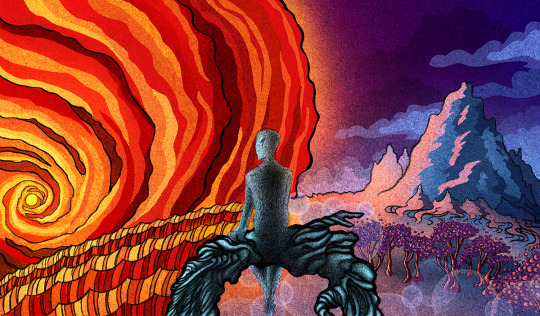
My own piece entitled: 美 which is the Chinese pictogram for “beauty”.
Now let us dig deeper into what I mean. If you recall from Game of Thrones Season 4 where Tyrion tells Jaime the story about their cousin Orson Lannister. He describes how in his simpleness, Orson would crush beetles all the day long, and Tyrion became obsessed with divining why Orson was doing this. He felt there had to be a reason, that there had to be some meaning behind what he was doing. Obviously, this story is an analogy. What Tyrion was really expressing was the aged old question, what does it all mean. I will paste the discussion below:
Tyrion: [...] In any case, I found nothing that illuminated the nature of Orson's affliction or the reason behind his relentless beetles slaughter. So I went back to the source. I may not have been able to speak with Orson, but I could observe him, watch him, the way men watch animals to come to a deeper understanding of their behavior. And as I watched, I became more and more sure of it: there was something happening there. His face was like the page of a book written in a language I didn't understand, but he wasn't mindless, he had his reasons. And I became possessed with knowing what they were. I began spending inordinate amounts of time watching him. I would eat my lunch in the garden, chewing my mutton to the music of "kun kun kun". And when I wasn't watching him, I was thinking about him. Father droned on about the family legacy and I thought about Orson's beetles. I read the histories of Targaryen conquests. Did I hear dragon wings? No, I heard "kun kun kun". And I still couldn't figure out why he was doing it. And I had to know because it was horrible, that all these beetles would be dying for no reason.
Jaime: Every day around the world, men, women, and children are murdered by the score. Who gives a dusty f*** about a bunch of beetles?
Tyrion: I know, I know, but still it filled me with dread. Piles and piles of them, years and years of them. How many countless living, crawling things smashed, dried out, and returned to the dirt? In my dreams, I found myself standing on a beach made of beetle husks stretching as far as the eye can see. I woke up, crying, weeping for their shattered little bodies. I tried to stop Orson once.
Jaime: He was twice your size.
Tyrion: He just pushed me aside with a "kun", kept on smashing. Every day. Until that mule kicked him in the chest and killed him. So what do you think? Why did he do it? What's it all about?
Jaime: I don't know.
This here is a perfect encapsulation of what I have observed in so many of our stories of late, stories which by their very nature are asking that aged old question, what does it all mean. Benioff and Weiss have just expressed it with a heavy hand here, while other writers and artists have a more subtle approach.
To make it clear what I am talking about, I want to draw a parallel between Tyrion’s story and what happened with Daenerys Targaryen. In this story, the audience is Tyrion – we are drawn to the story of Daenerys like Tyrion was drawn to the story of Orson. We were enraptured by her struggles as a character and divining the meaning of her story just as Tyrion sought to know the why of Orsen’s actions with the beetles. I mean isn’t that what we do as fans? We love going online and theorizing with other fans about what is going to happen, why it is going to happen, observing all the details of the plot and character arcs. We love seeking things out!
I cannot remember where I heard it, but it was in something I watched where they pointed out that audiences love to discover things on their own. They like being able to feel like they figured out something, that they found out something the writer had hidden or perhaps may not have been aware of. There is excitement in exploring the story, just as Tyrion was enthralled with understanding the truth and meaning behind Orson’s beetle slaughter. Yet what happened after all of Tyrion’s study, observations, ruminations, and questions? What happened to us the audience when we came to the end of Daenerys’ story? What happened to all that time and effort spent in watching, theorizing, and discussing? Despite Daenerys’ struggle as the underdog in her own story suffering abuse and pain - despite the awe of witnessing dragons coming to life from dormant eggs - despite all the lessons Daenerys learned as a ruler through her mistakes - all of it came to nothing. Just as Tyrion never divined the meaning behind Orson’s senseless slaughter, so we came to the end of Game of Thrones, having gained no beneficial understanding by our journey. Mad Queen Targaryen. Jon kills her. Orson gets killed by a mule. All the world burns. Beetles die for no reason. The End.
Tyrion: So what do you think? Why did he do it? What's it all about?
Jaime: I don't know.
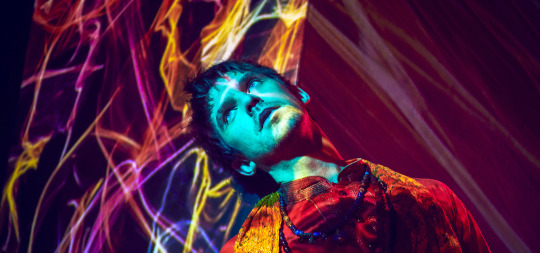
Game of Thrones isn’t the only show with these problems. In the FX show Legion, David Haller, the protagonist of the story, is suddenly twisted to become the show’s villain. He’s been Daenerys Targaryen-ed.
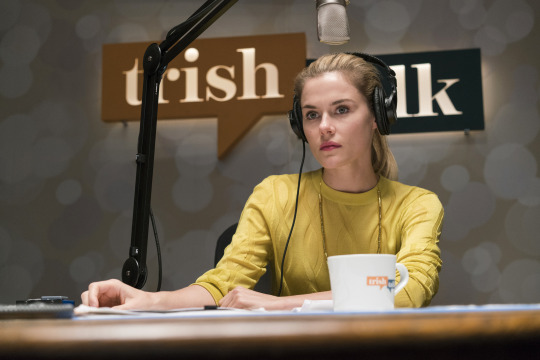
Trish Walker from Jessica Jones Season 3, also Daenerys Targaryen-ed.

This one is from a movie (it isn’t only in tv shows) and it is a little more subtle, but Professor X in Dark Phoenix was suddenly twisted as this arrogant douche who was controlling and manipulative - the “idol” of the X-Men school brought low. The “idealistic delusion” of Professor X as a heroic leader unveiled to show us the true frailties underneath! *GASP*
As you can see within the very fabric of Benioff and Weiss’s writing, nihilism pervades. It isn’t just in Daenerys’ story, but scattered throughout the stories of Game of Thrones - i.e. how Jaime Lannister went from redemption story to dying under a pile of rocks. Yet not only is nihilism pervading, but it is being romanticized, like there is something profound and powerful in its telling - like we are achieving some enlightened ideal in heralding its tenets. Many storytellers, not just Benioff and Weiss, have become just like that whole scene where Tyrion goes underground and discovers the dead bodies of Jaime and Cersei. Observe how the whole sequence was filmed in excruciating reverence, as we watch Tyrion walk through one ruin to the next. It is is a sobering moment, almost holy in how it is filmed - Tyrion’s silent pilgrimage as he approaches the thing he has dreaded most...
Remember how I mentioned in my previous post that every aspect of the cinematic arts is communicating something? The dialogue, the lighting, the way something is framed, what is shown vs what is not shown, the music, the colors, etc. I would encourage you to rewatch this scene and pay attention to how Benioff and Weiss are wanting you to feel as all these elements are spun together. And when Tyrion does finally arrive, after seeing Jaime’s golden hand amongst the rubble, Tyrion expresses a kind of ritualistic act as he removes the stones one by one, uncovering the truth. Oh, the existential dread! Tyrion weeps and thrashes in the horror and pain of it all! Woe, woe, woe! How powerful, how terrible, how divine!
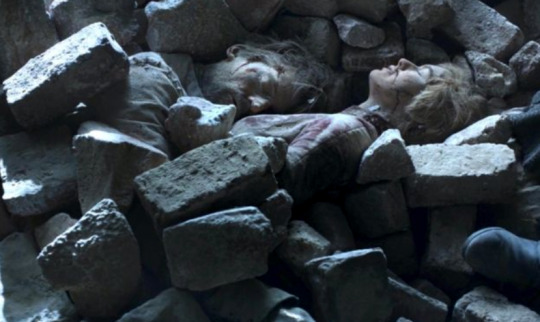
Observe the way Jaime and Cersei are orchestrated here. Despite being crushed by an onslaught of incredibly heavy stones and rocks, they are pictured here in peaceful and reverent positions - something akin to a Renaissance painting. How does that make you feel when you look upon it? The gentle, diffused white light, the atmosphere of ecclesiastical reflection - it is romantic, is it not? It is showing a glorified ideal! Behold the profundity of the nothingness!
Do you see what I mean? There is this glorification of showing the meaninglessness of life, of uncovering “the truth” that this life is full of ugliness and pain, of unmasking our delusions, of showing that there is always “someone behind the curtain”, our idols become monsters, our heroes become villains, it was all a lie, it was all a sick cosmic joke - and this is what empowers us and makes us wise. Oh, look how discerning and insightful we are as we reflect back to you the despair of a twisted humanity!
Me to Writers about how they believe their cynical worldviews are working in their stories:
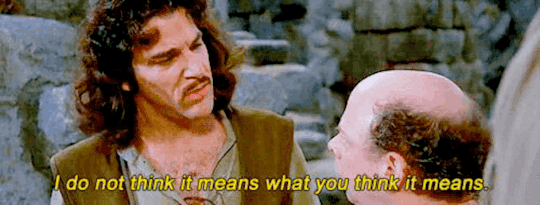
Now, I am not at all saying that stories cannot speak to the ugliness of this world, because there is truth in ugliness. There is pain, suffering, dread, brokenness, disillusionment, bitterness, anger, hate, and a myriad of dark and terrible things. I am not saying we should only tell feel-good stories where everyone lives “happily ever after”. No, what I am pointing out is an attitude that many storytellers have towards that ugliness. All artists have an obligation to speak to all truth, but there is huge difference between telling a story about ugliness vs making making that ugliness seem romantic. There is a difference between showing how life feels arbitrary and meaningless vs saying life is meaningless and arbitrary. There is such a big gap there.
So, I speak to all storytellers now: you are not profound for making statements about the despair of reality. You are not wise. You are not enlightened. It is easy for anyone to despair. It is much more difficult to rejoice in the face of that despair. It is easy to grow in bitterness and disappointment, much more difficult to believe in hope in the face of that disappointment. It is easy to observe ugliness, much more difficult to discern the beauty underneath, within, and despite it. And so that is what it really comes down to – it is easy to write a story like Daenerys “Mad Queen” Targaryen. It is easy to have her twist her own ideals and dreams into the dying screams of a burning city. It is easy to tell a story where someone falls than it is to tell a convincing and realistic story of redemption. It doesn’t require any work – nihilism is the lazy man’s philosophy. If all is meaningless, if nothing truly has any value, than that means you hold no responsibility to anyone or anything. It means you do not have to change the way you are doing things, that you can coast, lay back, and just watch the world burn. You can pat yourself on the back for being “woke” and not falling for the opiates of the masses. You don’t have to do any soul searching. You do not have analyze your own world view or assumptions. You don’t have to work at trying to understand what life truly means or try to find the purpose amidst all the chaos. There is no truth except the truth of nothing, therefore you are free to do nothing without guilt or shame. Nihilism is one big fat existential cop out!
Therefore, I say to all artists, storytellers, writers, showrunners, and creators – stop dishing out this crap for audiences to eat and get off your lazy asses and get to work!
26 notes
·
View notes
Text
The Oft Overlooked A BUG’S LIFE

A BUG’S LIFE…
What can I really say about this movie that other animation fans on the internet haven’t already? It was critically dubbed Pixar’s most mediocre film before the horror that is the CARS franchise.
I was about nine years old when this film came out, and I really liked it then. Honestly, I still kind of do, but admittedly some of it is nostalgia on my part and I’m well aware that it could have been better.
Like I said, this film has been talked about by other online critics about how it is okay, at best. That it was just the Pixar placeholder in between the first two TOY STORY movies. However for the purposes of this article I would actually like to highlight some of the good things about this movie, or at least my reasoning for why I still have a fondness for it.
Now before I continue I do feel like I should address two big elephants in the room: Namely, John Lasseter and Kevin Spacey. Knowing what we know now about them, if you can’t watch this movie without feeling uncomfortable, I totally understand. I’ll admit it makes me a wee bit uncomfortable to watch the film now, and more so the behind-the-scenes featurette on the DVD. (Wish I could blur their ugly faces when they’re being interviewed…)
However my opinions of this film on its own have nothing to do with them or whatever they contributed to the film, so they are irrelevant to what I have to say here. As far as I’m concerned if they hadn’t been involved in the film someone else would have taken their place, and those other people would have done just as good a job, if not better. Not to mention they would have been able to do it without being complete and utter creeps. To conclude, Lasseter can go suck a jellyfish and I hope Spacey rots in hell.
I’m going to primarily talk about the things I like about this movie, both then and now. But before I get to that I’m going to talk about why I agree with most critics who consider this one of Pixar’s lesser films.
A big problem with the movie is primarily the story and characters being a bit weak.
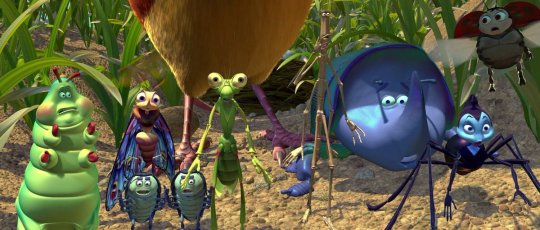
Part of that problem is the story’s initial structure. It’s clearly a retelling of Akira Kurosawa’s SEVEN SAMURAI; village is being attacked by thugs, one villager leaves to get help in the form of warriors, villager brings back help, and they successfully fight off the invaders.
Probably the biggest difference in story is SAMURAI ended on a bittersweet note due to casualties among the samurai themselves, whereas BUG’S LIFE didn’t have any real casualties on the heroes’ side. That said, though, it’s funny that the ants seemed so damn certain there would be.

Initially modeling an original story off of a classic isn’t a bad thing in of itself. Back when I was in college it was something a lot of my writing and animation professors encouraged: learn from the classics. Not just film, but also literature and mythology.
The thing is SEVEN SAMURAI as a film was three to four hours long. It had time to accommodate for its fairly large cast, while still keeping its focus on a select few.
BUG’S LIFE, however, was only maybe an hour and fifteen minutes long. The writers probably could have stood to trim down some of the Bug Circus and take time to polish the story rather than try to give EVERYBODY an opportunity to have a funny line.
Having a couple ensembles in place isn’t a bad thing. They had that in TOY STORY with Andy’s toys, the Little Green Men in the claw machine, and the mutant toys. The groups, however, were smaller in that movie, and in the case of the Mutant Toys they had no speaking lines and had to convey everything with silent acting.
However something that’s been pointed out is that with Pixar films there was always a real progression in technical quality. That with each movie they got better and better with the tool of their trade that was CG animation.
Let’s look back at TOY STORY. The reason they made the characters plastic toys was because that’s just what their character models at the time always looked like. It would be a long way before they could even consider rendering complex fur textures for MONSTERS INC., and more complex still Merida’s tangled head of hair in BRAVE. It’s why the human characters in TOY STORY also look a bit weird and plasticky by today’s standards.
With TOY STORY they accomplished lively character animation in 3D. With TOY STORY 2 they managed to make better looking, less stiff human models like Al of Al’s Toy Barn, and slightly nicer fur textures on Buster the dog. MONSTERS, INC. had the aforementioned complex fur textures for Sully and some pretty decent early snow effects.
So what did BUG’S LIFE accomplish on a technical level?
Two words: textures, and lighting.
The last time I watched BUG’S LIFE I was absolutely FLOORED by how beautiful the set pieces were.
Take this scene of Flik giving Dot a pep-talk.

All that detailing in the blades of grass in the background, the pebbles on the ground, the textures on the pebbles, the textures on Flik’s contraption, and even the textures on the characters. It blows my mind trying to imagine how long it took to create those models, differentiate between the more see-through nature of the grass blades and the opacity of everything else, and arrange them in a way that makes for a convincing bug’s eye view of a patch of grass.
Then there’s the scene of the grasshoppers breaking into the anthill.
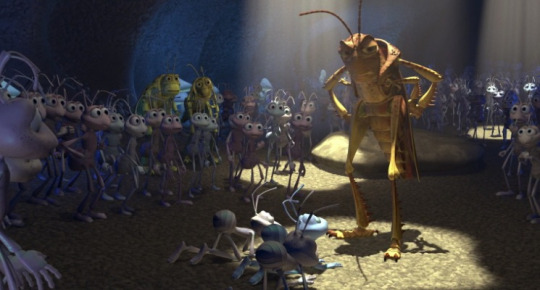
TOY STORY had some decent lighting that helped establish the needed atmosphere, but I don’t recall it being nearly this crisp.
Once again, there’s the textures on the objects and characters. As a kid, while I was aware the film was CG animated, I found myself speculating if the grasshoppers’ muzzles were made of foam rubber.
These were all things I took for granted as a kid, because I did not yet have the experience to know just how much work and skill it takes to make 3D animation.
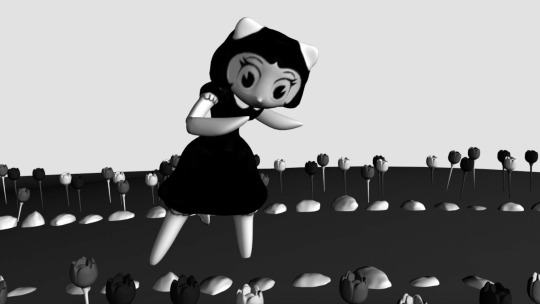
This is a still from a minute-long film I made in a 3D computer animation class. I was given maybe only a couple months to make it. That included having to navigate my way through these complex computer programs I was completely unfamiliar with, and technical difficulties like the textures not grafting onto the models right. Let me tell you, it was a pain in the ass.
I look at the backdrops for BUG’S LIFE and I’m left to ask: “How many computers CRASHED trying to render all that?” Because, believe me, that happens. A lot.
Also, here’s the thing. When technical elements of a film are done well, such as lighting or camera focus, the audience LITERALLY doesn’t notice it. They’re too swept up in the story because the visual storytelling keeps up the illusion for them. The audience only notices important technical details like this when they’re done BADLY, hence a lot of people outside the film industry really take for granted just how much work and skill is taken into making a film that looks good.
(It’s why I think everyone should watch FOOD FIGHT at least once in their lives, especially animation fans.)
Okay, while it is inevitable that I would bring up Dreamworks’ ANTZ, I’m not going to talk too much about it. (It’s like the Cola Wars; everyone inevitably picks a side.) All I’ll say for now is I’ve always preferred BUG’S LIFE because it’s nicer-looking design-wise and its content and execution is more family-appropriate. (Also, in 1998 we didn’t know at the time Kevin Spacey was a creep, but everyone and their DOG knew Woody Allen was. Nice job, Dreamworks!)
It’s been pointed out that there’s a distinct casting difference between ANTZ and BUG’S LIFE. ANTZ had a cast of recognizable movie actors, while BUG’S LIFE had a cast of recognizable television actors.
For BUG’S LIFE that’s not necessarily a bad thing. One of the things that bothers me about celeb casting in animated movies is that oftentimes it feels like a flimsy attempt at star-power when said stars don’t have the power to elevate the characters. Actors who might be good front of a camera but bring nothing to a recording booth.
However for the most part Pixar has been really good at casting well-known actors who actually fit their characters and add some personality to them. BUG’S LIFE was no exception.
In fact, quite a few of them had loaned their voices to animation before this film, and some damn good performances too.
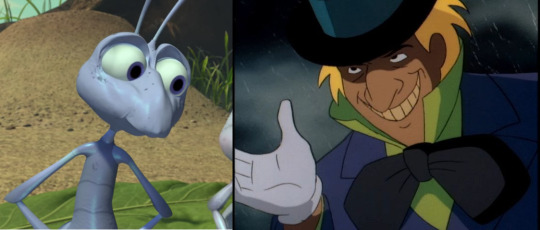
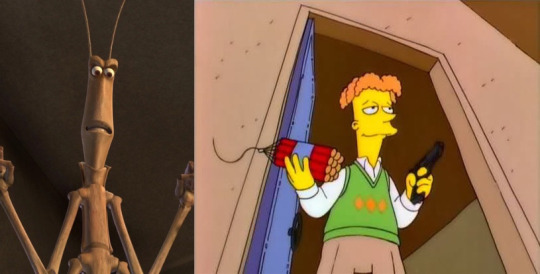
And I can name at least one BUG’S LIFE alum who graduated from funny performance to heartfelt performance with Pixar…

(… I’m not crying! YOU’RE crying!)
But I digress. I consider the casting for this movie pretty solid. (With the obvious exception of Kevin Spacey.)
What’s more, growing up I remember a lot of the TV spots for Pixar films usually down-played the celeb cast and let the product speak for itself. The celeb casting was less of a selling point for the films and more like a fun little Easter egg for the parents who had to take their kids to the theater.
Earlier I stated that the story and characters in BUG’S LIFE are a bit weak, and I stand by that. However there are a couple characters I’d like to highlight here as I’ve always found them interesting and memorable in their own ways.
First, let me talk about Hopper for a minute.
(I’ve already stated that Kevin Spacey can rot in hell, so there will be no more of that.)
I’ve heard criticism about Hopper as a character that he was a very bland, one-dimensional villain. To be fair, they’re not wrong.
But the thing I always liked about Hopper is that his one and only goal is to hold dominion over the ant colony. To keep them under his foot, both literally and figuratively, and he wasn’t afraid to use deadly force to do that. He was willing to kill a few of his own goons just to illustrate a point. That’s how threatening he was.
In a lot of children’s media I had seen up to that point, there were several bully characters that were often portrayed as the bigger kids who would demand your lunch money. They were usually ineffectual doofuses like Bulk and Skull from POWER RANGERS, or kids with serious insecurities like Binky Barnes from ARTHUR. While not the first of his kind, Hopper was one of the first characters I had ever encountered as being a prime illustration of not just a bully, but one who had the makings of a dictator.
With his rather one-note motivation, I can see why audiences found him bland, but given his violent means of staying in power, I’m glad they didn’t try to make him “complex” or give him any sympathetic character traits.
Frankly, we live in an age where horrible people are romanticized in the media as being “misunderstood”. I feel like, unlike those media outlets or the upcoming JOKER movie, BUG’S LIFE gets it. They don’t deserve to be portrayed with humanity. These people are monsters. Nothing more.
Maybe if Pixar hadn’t felt the need to rush the production maybe Hopper is one of many characters that could have been polished up a bit in the writing process. Give him some more distinct, memorable traits as a character. Maybe hints at a backstory of Hopper having a long-standing history of using and abusing others, and always getting away with it.
(When I put it that way, we can just say Hopper is the John Lasseter Story. Just draw a pair of glasses and a tacky shirt on the guy and it’s a spitting image.)
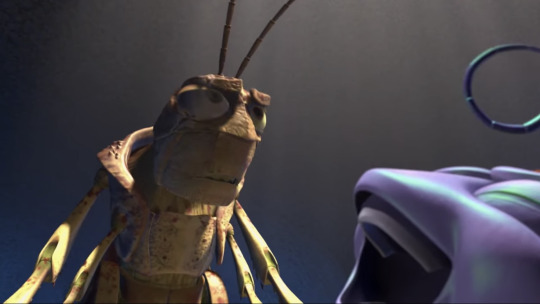
The other thing I’ve always liked about this movie was the portrayal of Princess Atta.
Besides being the first Pixar Princess, I always liked how, unlike the Disney Princess pantheon up to date in the late 90s, Atta actually had a bit of a character arc related to the fact that… well, she’s royalty! She’s going to have to take over the colony eventually as queen.
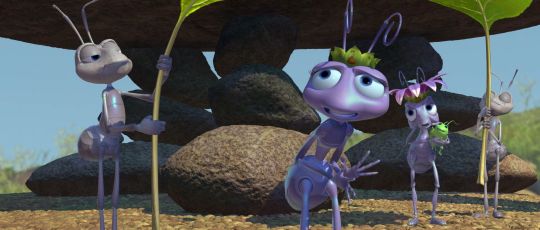
We see this from the beginning as she’s overseeing the harvest and going into a panic when things go even slightly wrong. Also, I find it interesting that it’s a guy that screws everything up when Flik accidentally destroys the food offering, yet she’s the one who gets blamed for it. (Ironic commentary coming from the studio led by an egotistic creep who wouldn’t let women in on meetings.)
But what I loved about her as a kid was that her personality and approach to things was a lot more real and down-to-earth than your average glamorous Disney Princess. She felt less like fairy tale royalty and more like a woman up for promotion at a big company. From a pragmatic standpoint that can be just as scary, stressful and daunting.
(It also feels appropriate in hindsight considering her voice actress Julia Louis-Dreyfus would later star on VEEP…)
My friend @baxterfilms and I have had a lot of discussions about this movie, and we agreed that Atta should have been the protagonist. She actually has a character arc of her own of being unsure of herself at the start of the film, taking charge in the second act, and eventually standing up to Hopper in the third.

Remove Flik entirely, and have her go on a journey to find reinforcements against the grasshoppers. Have her realize that Hopper’s demands are impossible, she’s sick of having to adhere to him, and have her sneak out to get help. When she finds out she literally brought home a bunch of clowns, she understandably freaks out. She has to figure out a resolution because there is a lot of pressure on her to make things right and free the colony from bondage.
Strangely enough, with that version of the story you could still probably have all the indulgent fun of the celebrity cast. It’s just the very core of the film’s story needed some serious tightening up, and maybe Dave Foley as Flik would have fared better as a comic relief sidekick.
With all that said, I thank you for taking the time to read this. I really do think that this film is highly under-appreciated in the animation community. There might have been trouble in the writing room, but the technical achievements in this film were still there and helped Pixar hone their craft into making their animated features as stunning as they are heartwarming.
I have to say, though, I find it funny that there’s almost a pattern to these insect-driven animated movies. Going all the way back to MR. BUG GOES TO TOWN, they usually have rather weak leading characters, and the supporting cast winds up leaving more of an impression.

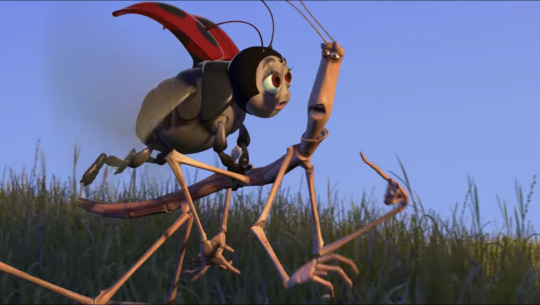
Weird, huh?
10 notes
·
View notes
Text
A wishlist for the Godling of Sau
((Long post ahead, hit J if you don’t want to see my rambling))
Yesterday I wrote a post about disability in Godsfall and how it was handled poorly in the most recent episode, and last night I received a reply from @xion-from-godsfall. The reply and my response to it are here. Now, I went through a lot of stuff in that response, but I wanted to more directly address one bit, the Godling of the Astral Plane.
Aram (@godsfalldc) has talked a lot about how he’s drawn inspiration from comic books and superheroes. Superheroes and comic books are great and have historically been a wonderful way for minorities to express themselves, but there are a number of ableist superhero tropes that basically go unquestioned.
Specifically, here’s the elevator version of why I’m nervous about what you’re doing with the Godling of Sau and a few tips on how to fix it.
From episode two of Godsfall, the Astral Plane has been associated with seeing the unseen. Sau’s presence in the show has been primarily through the Eye of Sau. So when I heard that the Godling of the Astral Plane was going to be blind, I feel fairly justified in jumping to the conclusion that you’re going to play her as a blind seer.
So what’s wrong with the blind seer trope? Here’s an article about tragic and magical disabilities and here’s another about the specific treatment of blindness in fantasy and science fiction. You don’t have to read them, but I’d recommend that you do because, like everything, you can’t learn shit from staring at a link and hoping you’ll open it next week. Just in case you don’t, the short version is that giving your character a disability and giving them a magical power that immediately cancels it out is, at best, fucking trash writing.
We already have Geordi LaForge and Daredevil. Even if those two were the only two blind characters who essentially have their blindness canceled out by ~future science~ and ~special powers~, we’d have already filled all of the necessary slots for that specific trope. Ever. Seriously we don’t need more. Please.
So what can you do to steer clear of these tropes while still keeping the character I know you’ve worked hard on? Keeping in mind that I’m sighted and thus not an authority on blindness or portraying blind characters (although I did do my research), here’s my wishlist for the Godling of the Astral Plane
Don’t use her godling abilities to cancel out her disability: Just because the Astral Plane has been associated with sight so far doesn’t mean that it has to be. Maybe your godling can hear magic. Maybe she has synesthesia and the things that would ordinarily be visual are translated into another sense. Be creative and don’t use the “she’s blind but she can see on another plane of reality” cop out unless you really can’t avoid it. (I put this first, but it’s really the most optional. If you want her to actually see in the Astral Plane, go ahead. Just please consider other, more creative, options and don’t let her Astral sight translate into erasure of her Material Plane disability)
Make it really, really clear that her blindness and Astral Plane powers aren’t causally connected: Toph from ATLA is one of the best representations of a blind character who “sees” through other means. Her powers are cool, but they’re also clearly an adaptive ability that she’s learned over time and that can be taught to other earthbenders. You’re obviously not going to be able to pull that off, but you can at least establish early on that her powers neither caused nor are a result of her blindness.
Actually research blindness: As a general piece of advice to anyone who ever tries to write a disabled character, your #1 goal is to know your shit going in. Keep in mind that only about 2% of blind people have no vision whatsoever. Find a diagnosis that fits what you want the character to be able to do and find at least a couple of articles/blog posts/etc about what it’s like to live with that condition.
Don’t let the players (or the audience) forget that she’s blind: This is actually one of the really great successes of Toph as a character, her disability colors the way she interacts with the world. Blind people have a lot of mannerisms that sighted people wouldn’t notice. For instance, my grandmother has identical salt and pepper shakers, she shakes them and figures out which is which from the sound. Showing how she interacts with her environment using touch and sound will both give depth to her character and increase immersion in the world
Give her needs, but don’t go overboard: Blind people can do a lot of stuff on their own, but if nothing else she’s not going to be able to read text and will struggle to get around in unfamiliar spaces. Canes, fantasy braille, and people who are able to read street signs are going to be staples of her life and showing these needs will go a long way towards positive representation. Her specific needs may vary depending on the exact type of vision loss she has, but rehabilitation websites are probably your best bet for a comprehensive breakdown of what real-life blind people use
Lampshade the fuck out of this: I can’t tell you how to run your world, but our own world has thousands of stories about blind seers ranging back at least as far as ancient greece. It would make total sense for her to make at least one joke about how absolutely bullshit the blind seer trope is.
And finally (and I hope this one is redundant) don’t cure her blindness: I don’t care how much Pera wants to burn her face off, using magic to cure disabilities is bad representation and bad storytelling. Don’t do it.
That was a lot longer than I wanted it to be, so I hope it makes sense. I hope this post reaches the Godsfall crew before you record your next session, but if it doesn’t I hope you’ll keep the magical disability issues in mind for the next time.
Also, if anyone has stuff to add on to this post please do.
#shut up alan#text#godsfall#dungeons and disabilities#I know this isn't the ideal way to reach the cast but tumblr is where I'm best at communicating#i guess i could do email?#okay I'm sure I could add a bunch more shit but I'm going to post because otherwise I'll psych myself out and I need to sleep
8 notes
·
View notes
Text
A Lavish Feast for Every Yeast
We produced The 25th Annual Putnam County Spelling Bee in 2009. Our audiences loved it, our actors loved it, and though I enjoyed watching performances, I didn't enjoy directing it all that much.
Why not?
It required almost nothing of me. Roughly 95% of blocking rehearsals were me saying, "Okay, then you get up and cross to the mic... then when the song's over, you go back to your chair..."
It's true that I did get to help the actors with characters, backstory, all that fun stuff. Despite the fact that most productions treat this show like it's sketch comedy, it's not; it's really rich and well-crafted. The characters are complex and nuanced, and Spelling Bee tells some Big Truths about the adult world. It's a masterful piece of theatre that doesn't get the respect it deserves.
But it wasn't very fun for me to stage.
Yeast Nation has been somewhat similar for me, though not to the extreme of Spelling Bee. With Yeast Nation I feel like the craftsman in me has been kept crazy busy, but not the artist as much. Blocking this show has been primarily about sightlines and traffic control -- so much is going on, so many characters come and go, as our writers juggle all these crazy narratives threads throughout the show.
As Sondheim has said many times, the most important question is always: are we being clear? We can't control whether an audience likes or "gets" our show; we can control whether our storytelling is clear.
Rob has given us a crazy set, an abstract kind of reef, shaped like a big raked croissant, with the audience on three sides. That will be an awesome playground for our actors, but it makes my traffic patterns even more challenging. On the other hand, Kotis and Hollmann love using a split-screen effect, so this reef naturally gives us a number of semi-isolated playing areas, which is helpful.
There are a couple big songs in the show in which we "split the screen," not just two ways, but more. In "Alone," the screen first splits two ways, with Wise and Elder talking in one area, while Second swims to the surface. Then it "splits" again, and we see Sweet feeding the poor. And they're all singing.
In the middle of "Look at What Love Made Me Do," the "screen splits" between Second and Sweet, then Wise in another "screen," then Sly and Unnamed in another "screen," then the Yeast Chorus in two more "screens." A six-way split-screen. That's not something you would have seen during the Rodgers & Hammerstein era, but audiences are so used to modern film techniques, that we easily accept stuff like this.
West Side Story used a multi-split-screen in the "Tonight" quintet, but I can't think of another true "split screen" onstage until Company.
In the 1970s, Michael Bennett and Hal Prince experimented with using film techniques on stage (particularly in musicals), but Bennett was really at the height of his powers in 1981, with Dreamgirls, where his staging used pans, close-ups, focus-pulls, reverse angles, dissolves, etc. Today, all that is just the common visual language of modern musical theatre. Look at shows like Les Miz, Next to Normal, Passion, Sweet Smell of Success, Grand Hotel, Passing Strange, Spring Awakening, American Idiot, and so many others.
Michael Bennett died way too young, but he moved us so far ahead.
Directing Yeast Nation, I'm finding my two biggest jobs are to act as both a guardrail and a permission-giver. Those are always part of my job, but in this case, I think they are primary. As guardrail, I have to keep us all in this very specific storytelling style, and not let us lose the stylistic overlay or the core emotional honesty. Those two have to stay in balance for this show to work right.
My role as permission-giver is always my favorite part. Actors -- even the freest and most inventive actors -- usually need explicit permission to go for it. Anytime we're staging a fight, at some point early on, I have to say to the actors, "Okay, you guys, now come one and fucking fight!" And then they do, and the scene crackles with electricity, and they're then free.
I think a lot of actors -- most? -- think that extreme emotions are essentially the equivalent of over-acting. But that's so wrong. Over-acting means taking the acting beyond the material to a different (arguably, wrong) place. But extreme emotions are real. Real people experience extreme emotions every day, though most of us are fairly good at emotional camouflage.
Just as good news is not usually News, so too ordinary emotions are not particularly dramatic. No one wants to be told a story about a woman whose life is fine and she's cool with it. That's not dramatic, because there's no conflict, no struggle; and we need conflict and struggle in our stories, because humans tell stories to make sense of ourselves, our lives, and the world around us. And the world around us is chock full of conflict and struggle.
The more a story, however ridiculous, speaks to your real-life experience, even if you don't consciously recognize it, the more that story feeds you what you need. That's why people respond so powerfully to shows like Rent. You don't have to be a bohemian in the East Village to learn something of value from Angel, Tom, Roger, Mark, Maureen, and the gang. You don't have to be trapped by a man-eating plant to recognize the very human emotions and insecurities in Little Shop. And you don't have to be a Jewish dairyman to find deep resonance in Fiddler on the Roof
One of the great rules of storytelling is that the more specific the details get, the more universally the themes will resonate with the audience. And you can't get much more specific than single-celled yeasts on the floor of the ocean three billion years ago. In Yeast Nation, the royal princess desperately wants the throne, but even if you're not royal and you're not a single-celled yeast, you can still understand her feelings, insecurities, frustration, etc.
Because no matter what a story is about, it's about you. That's the essential point of storytelling.
Maybe now that we're done blocking and we're moving into the theatre, my first job, above all others, is just to make sure we're telling the truth, and not getting carried away with the fun and glorious weirdness of our story's content. The funny will take of itself -- the writing is that good -- but we have to take care of the truth this show is telling, about human nature, about ambition and betrayal, about progress and sacrifice, about love and desire and primal appetites.
One of the great joys of the original Star Trek is that they could tell stories about the most immediate, most relevant issues of the moment, because those issues were always thinly veiled behind aliens and spaceships. Likewise, Yeast Nation is all about us, here, now, but that thin veil sure is a lot of fun.
I can't wait to get the actors on the set next week!
Long Live the Musical!
Scott
Click Here to Buy Tickets!
from The Bad Boy of Musical Theatre http://newlinetheatre.blogspot.com/2018/05/a-lavish-feast-for-every-yeast.html
0 notes